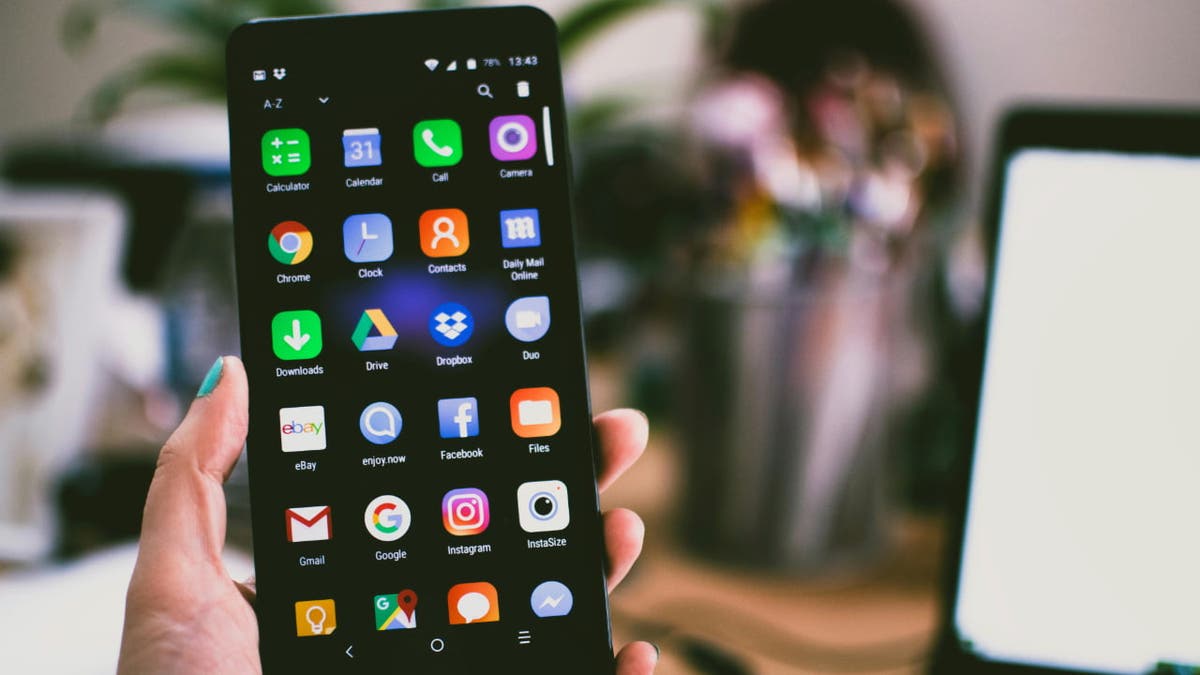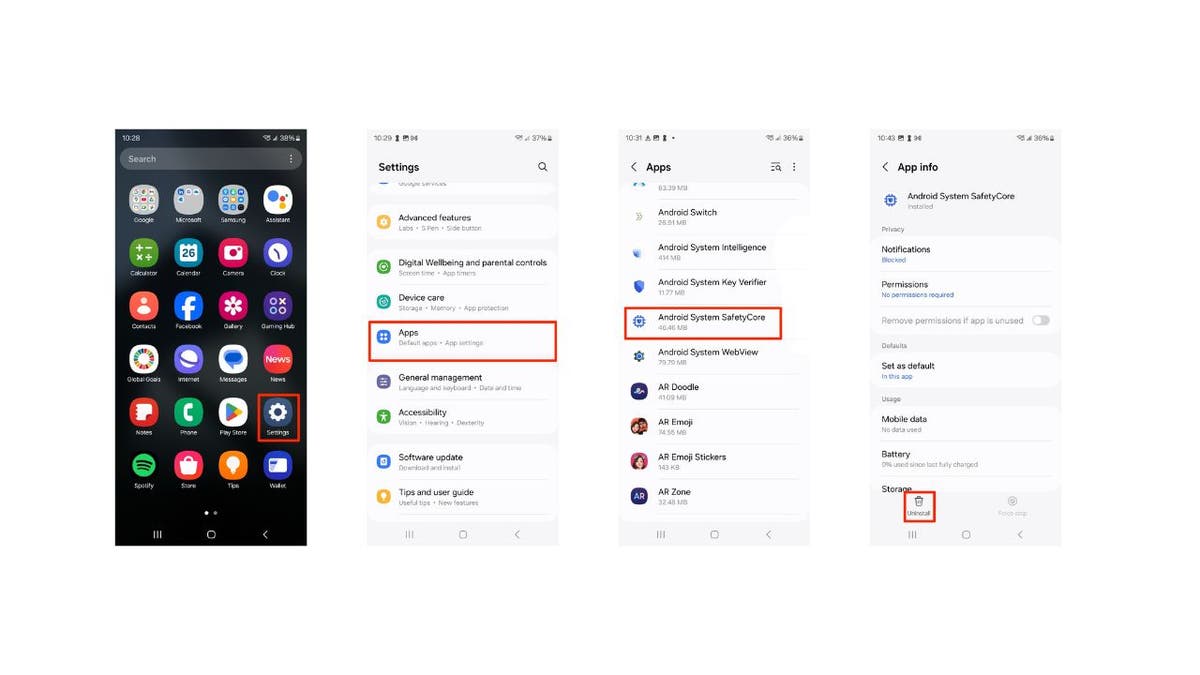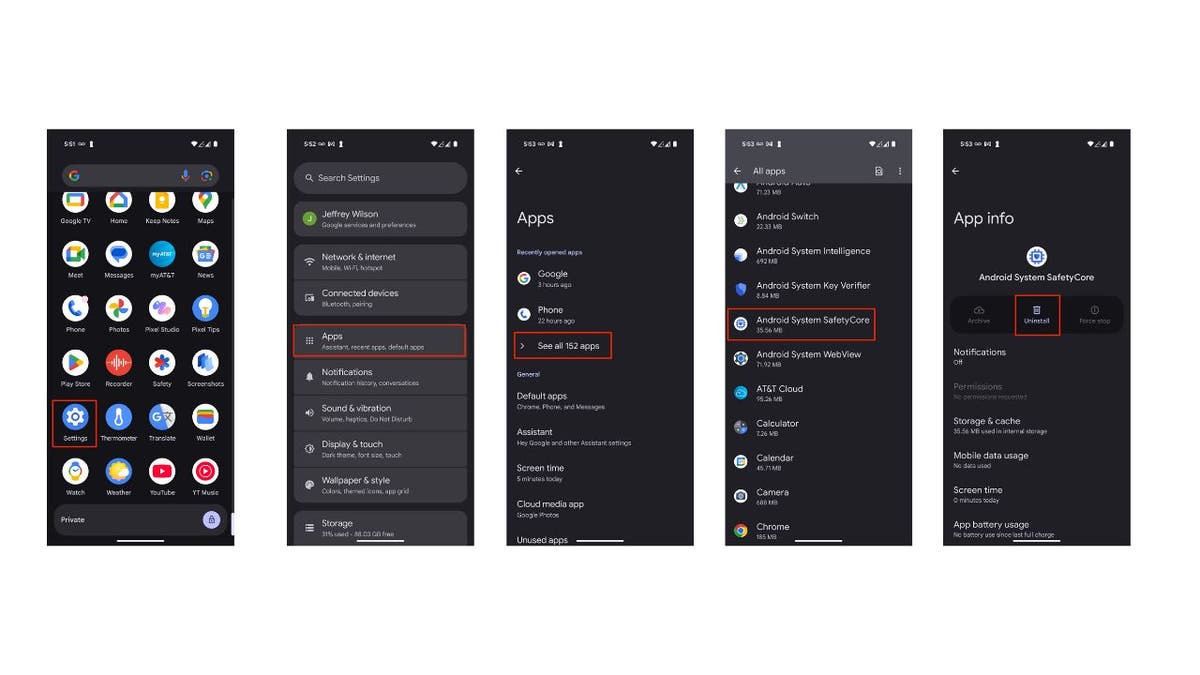
Have you ever stumbled upon a mysterious app in your Android system settings called “SafetyCore”? If so, you’re not alone. Introduced in late 2024, this system service aims to enhance on-device privacy by detecting sensitive content like nudity and enabling features such as Sensitive Content Warnings in Google Messages.
While Google assures users that SafetyCore operates locally without sharing data externally, it has still sparked confusion over automatic updates. Let’s dive into what SafetyCore does, how it works and the steps you can take to disable it if you choose to do so.

A man scrolling on his Android phone (Kurt “CyberGuy” Knutsson)
What you need to know
By definition, SafetyCore is a system service that provides on-device machine-learning infrastructure to help detect sensitive content. It was introduced as part of Google’s Nov. 7, 2024, system update for Android 9 and later.
Google initially described SafetyCore as a tool that supports privacy-preserving user protections for apps. One of its first visible uses was in Google Messages, where it enables Sensitive Content Warnings, a feature that blurs images potentially containing nudity and prompts users with additional options before they can view or send them.
By default, Google System services automatically update your device with security, bug fixes and new features. Some updates are delivered via system services in separate Android packages. This maintains privacy, security and data isolation following the principle of least privilege because permissions are not shared with other functionality.
SafetyCore does more than detect nude images. Its built-in machine-learning functionality can also target, detect and filter images for sensitive content. There is no app icon, and it doesn’t appear in the usual list of running applications. Users must navigate through Settings > Apps > Show system processes to find it.

A woman holding an Android phone (Kurt “CyberGuy” Knutsson)
BEST ANTIVIRUS FOR ANDROIDS – CYBERGUY PICKS 2025
What does Google say?
Google maintains that SafetyCore is purely an on-device classification service and does not report or share scanned content with Google or other entities. The company argues that the service enhances security without compromising privacy, allowing apps to detect and filter unwanted content locally.
We reached out to Google, and a spokesperson told Cyberguy, “Android provides many on-device protections that safeguard users against threats like malware, messaging spam and abuse protections, and phone scam protections, while preserving user privacy and keeping users in control of their data.
“SafetyCore is a new Google system service for Android 9+ devices that provides the on-device infrastructure for securely and privately performing classification to help users detect unwanted content. Users are in control over SafetyCore, and SafetyCore only classifies specific content when an app requests it through an optionally enabled feature.”
Google also says that as part of its continuous investment in the transparency of its products, the company is going above and beyond, adding binary transparency to SafetyCore. This allows users and developers to verify that SafetyCore is truly privacy-preserving, just like Google says it is.

A Samsung phone (Kurt “CyberGuy” Knutsson)
LOOKING FOR MORE WAYS TO LOCK DOWN YOUR ANDROID? HERE’S HOW TO DO IT
How to remove Android SafetyCore
Settings may vary depending on your Android phone’s manufacturer. (Note: We tested these steps on a Samsung Galaxy S24 Ultra.)
If you wish to uninstall or disable SafetyCore on your Samsung Galaxy, follow the steps below:
(Note: If you decide to disable or get rid of System SafetyCore, you may not be able to benefit from the new security and privacy features or enhancements that Google offers now or in the future.)
- Open the Settings app on your device
- Tap Apps
- Scroll through the list or use the search bar to find Android System SafetyCore
- Tap on Android System SafetyCore and check if the Uninstall option is available. If Uninstall is available, tap it to remove the service. If Uninstall is grayed out, you may only be able to Disable it

Uninstall or disable SafetyCore on Samsung Galaxy (Kurt “CyberGuy” Knutsson)
If you wish to uninstall or disable SafetyCore on your Pixel device, follow the steps below:
Settings may vary depending on your Android phone’s manufacturer. (Note: We tested these steps on a Pixel 9 Pro.)
- Open the Settings app on your device
- Tap Apps
- Select See all apps
- Scroll through the list or use the search bar to find Android System SafetyCore. Tap on Android System SafetyCore
- Check if the Uninstall option is available. If Uninstall is available, tap it to remove the service. If Uninstall is grayed out, you may only be able to disable it

Uninstall or disable SafetyCore on Pixel (Kurt “CyberGuy” Knutsson)
HOW TO CANCEL SUBSCRIPTIONS ON AN ANDROID TO SAVE MONEY
4 ways to keep your personal information safe
If you’re concerned about Google’s data collection and want to keep your personal information safe, here are four steps you can take.
1) Limit app permissions: Regularly review and restrict app permissions, especially for access to your camera, microphone, storage or location. If an app doesn’t need access, revoke it in your device settings.
2) Disable background data and tracking: Prevent unnecessary tracking by turning off background data for apps that don’t require constant internet access. You can also disable location tracking and opt out of Google’s personalized ads in your account settings.
3) Use a VPN for secure browsing: A VPN (virtual private network) encrypts your internet traffic, preventing your ISP, Google or other entities from tracking your online activity. Privacy-focused VPNs are great options that do not log user data. For the best VPN software, see my expert review of the best VPNs for browsing the web privately on your Windows, Mac, Android and iOS devices.
4) Regularly clear personal data: Delete unnecessary stored data such as search history, location history and cached files. You can do this in your Google Account settings and within individual apps to minimize your digital footprint.
Kurt’s key takeaway
SafetyCore is an interesting addition to Android, offering on-device content filtering with machine learning. While it aims to enhance privacy and security, some users might have questions about its presence and functionality. Whether you decide to keep it or explore disabling it, staying informed about your device’s features is always a good idea. This way, you can make choices that best fit your needs and preferences for managing your Android device.
Do you trust Google’s claim that SafetyCore operates entirely on-device and does not share your data? Let us know by writing us at Cyberguy.com/Contact.
For more of my tech tips and security alerts, subscribe to my free CyberGuy Report Newsletter by heading to Cyberguy.com/Newsletter.
Ask Kurt a question or let us know what stories you’d like us to cover.
Follow Kurt on his social channels:
Answers to the most-asked CyberGuy questions:
New from Kurt:
Copyright 2025 CyberGuy.com. All rights reserved.



